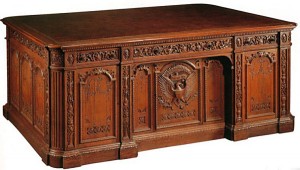Remote Viewing Objects:
The Resolute Desk

Task: The Resolute Desk
Task cue: “Describe the most important aspects of the target, and its purpose and function.”
I was semi-frontloaded because I knew that I was remote viewing an object, but I was “blind to the task” (I did not know what it was).
The Resolute Desk is a large, nineteenth-century partners desk, currently used by President Barak Obama in the Oval Office. It is one of five desks available in the White House for use by U.S. presidents.
The Resolute Desk was a gift from Queen Victoria to President Rutherford B. Hayes in 1880 and was built from the timbers of the HMS Resolute, a British Arctic Exploration ship. Franklin D. Roosevelt built a small door in the gap, so people couldn’t see his wheelchair. The panel was commissioned in 1944, but it was not delivered until after the president’s death on April 12, 1945. President Harry S. Truman had the panel installed to honor Roosevelt’s memory.
The panel features the Presidential Seal—one of only four in the White House that have the eagle’s head turned towards its left talon, which holds 13 arrows, instead of the now-official arrangement in which the eagle’s head is turned towards its right talon, holding the olive branch with 13 leaves.
Remote viewing is a continual learning process. Each session provides an opportunity for the viewer to learn about how “they” remote view. In this series I am exploring how I remote view objects. This is very different from remote viewing people. When you remote view a person, an empathic connection is formed, which may feel as if you are having a conversation with them.
When remote viewing objects, the focus is on the function of the object, what is it used for, and perhaps how other people feel about it. In this session I focused primarily on the Presidential Seal, which I found interesting. In this session, I utilized Stage 6 clay modeling, which provided a more physical interaction with the object. Molding the clay feels as if I am actually touching the object. From this interaction, more information about the object can be obtained.
Post Your Comment on Facebook
Powered by Facebook Comments